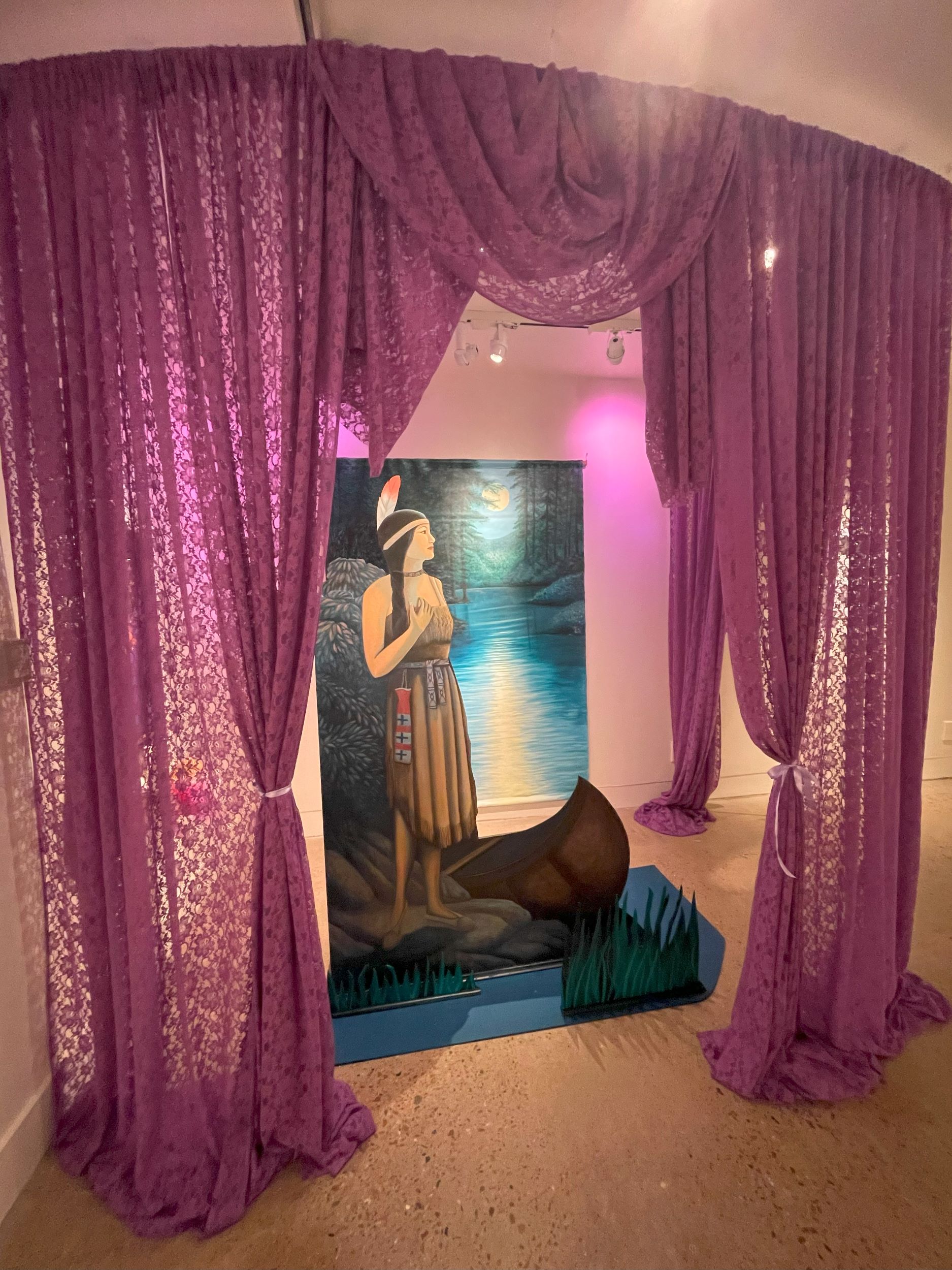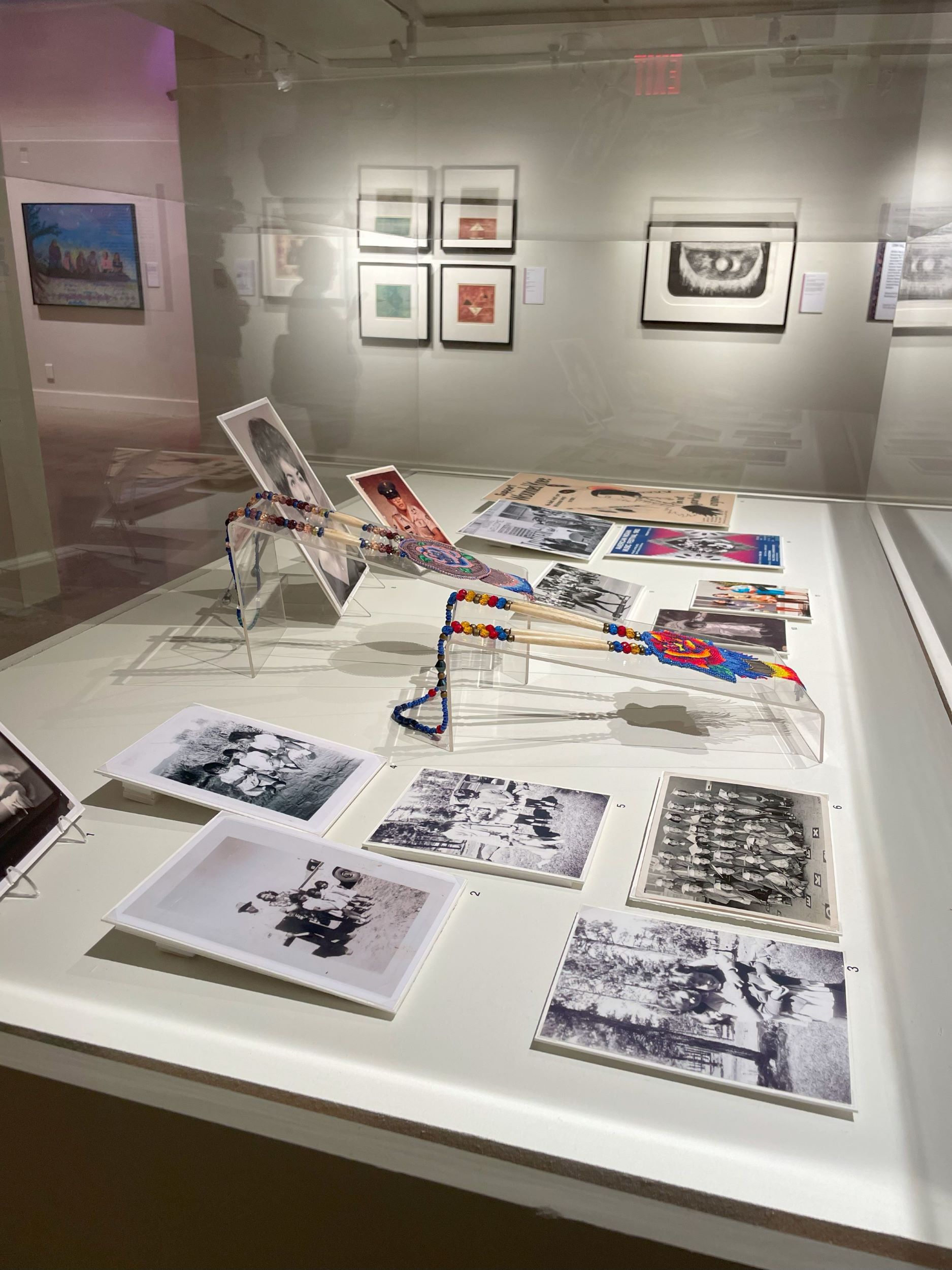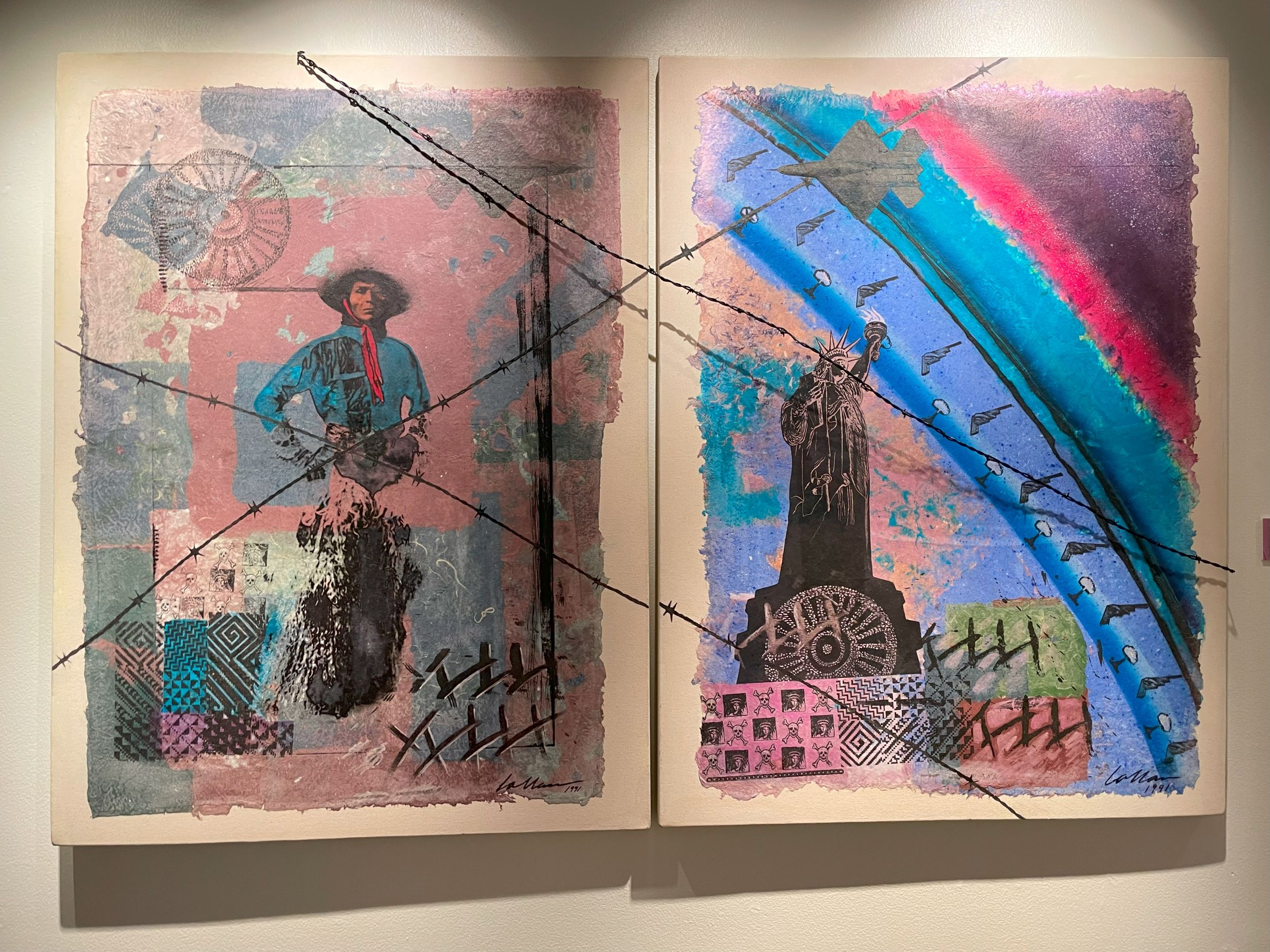The Art of Jean LaMarr
PDF: Kane and Kreisel, review of The Art of Jean LaMarr
Curated by: Ann M. Wolfe, Nevada Museum of Art, and Manuela Well-Off-Man, IAIA Museum of Contemporary Native Arts (MoCNA)
Exhibition Schedule: Nevada Museum of Art, Reno, NV, January 29–May 29, 2022; Boise Art Museum, January 28–June 11, 2023; MoCNA, Santa Fe, NM, August 18, 2023–January 7, 2024
Catalogue: Ann M. Wolfe, ed., Jean LaMarr, exh. cat., with contributions from Allan L. Edmunds, Mary Lee Fulkerson, Debra Harry, Archana Hortsing, Lucy R. Lippard, Susan Lobo, Judith Lowry, Malcolm Margolin, Vincent Medina, Anya Montiel, Raymond Patlan, and Jan Rindfleisch. Reno: Nevada Museum of Art, 2020. 220 pp.; approx. 200 illus. Hardcover: $40.00 (ISBN: 978-0-9658115-6-9)
“Learn from the Purple Flower Girl”

The Art of Jean LaMarr is a traveling exhibition curated by the Nevada Museum of Art’s Ann M. Wolfe, on view from August 18, 2023, to January 7, 2024, at the Institute of American Indian Art (IAIA) Museum of Contemporary Native Arts (MoCNA) in Santa Fe, New Mexico, supervised by chief curator Manuela Well-Off-Man.1 This is LaMarr’s (Northern Paiute/Achomawi) first solo museum retrospective. After its launch in Nevada, the traveling exhibition was most recently at the Boise Art Museum. Located in three separate galleries of MoCNA, the show is visually cohesive and pointedly challenging of uninformed, antiquated, and racist iconography that has been proliferated by white settler culture in the United States.
One of the clearest examples of LaMarr’s acute awareness of the power and history of these images is the “Selfie Spot,” a station where viewers can step into a life-size scene with the fictional character “Princess Pale Moon” and take a selfie (fig. 1). Princess Pale Moon is based on “Minnehaha,” a racialized and sexualized character made up by Henry Wadsworth Longfellow, whose usage was damaging to Indigenous women at his time and remains so today. The artist interrogates this imagery and its creator by turning the patriarchal gaze onto the viewer, using what the label calls “reverse cultural appropriation.” The scene demands an interaction, juxtaposing the “civility” of whitewashed history against the selfie participants. The label describes LaMarr’s comments related to this installation: “’Humor is our savior,’ LaMarr says of watching them [the selfie takers] ‘play Indian.’”2
Beyond the entrance to the museum and main gallery, there is no prescribed path through the gallery spaces, which are organized thematically and not exclusively chronologically. In the center of the main gallery, the viewer encounters a newly constructed installation, a traditional willow sweat lodge. This sculpture uses Indigenous architecture as a metaphor for the tragedy and aftermath that LaMarr’s family experienced at the hands of the US federal government. In 1924, the artist’s mother and four aunts were taken and forced into the Stewart Indian Boarding School in Carson City, Nevada. In the accompanying wall label, LaMarr says the sculpture represents “the process of cleansing and healing from this trauma.” She placed pictures of child victims from boarding schools all over North America on the exterior of the sweat lodge and united the entire piece with orange fabric ties that hold the willow poles together. The label notes: “In Canada, the color orange is worn annually on September 30—otherwise known as National Day for Truth and Reconciliation—acknowledging the lingering impacts of residential boarding schools.” Indigenous nations utilize orange as a protest color specifically aimed at bringing awareness to the tragedies imposed on boarding-school children, the enduring legacies of violence, and the loss of Native social practices. A 2022 investigative report completed by the US Department of the Interior confirms the multigenerational program of displacement, forced assimilation, cultural severance, and extensive corporal violence that was implemented in order to expand the territory of the United States.3 LaMarr’s inclusion of the orange accents may be a quiet attempt to encourage the United States to also adopt the Canadian day of recognition regarding genocide.
A unifying color scheme of primarily white walls with purple accents runs throughout all three galleries. Every artwork is visually supported by purple, ranging from shades of violet, to plum, to lilac. Furthermore, many of LaMarr’s artworks employ these colors both in representational and abstracted compositions. These are, of course, intentional choices. On the amethyst purple wall adjacent to the title wall, a text panel explains:
The color purple was beloved by Jean LaMarr’s maternal grandmother Libby Joaquin (Northern Paiute). Today, it is LaMarr’s favorite color, conjuring memories of the lilacs, lupine, and long mountain shadows of her homelands in Susanville, California. Her grandmother was with her in 1948, when LaMarr was given the Northern Paiute name Pahime Gutne, or “purple flower.” To this day, the color purple has become an integral part of LaMarr’s personal identity.4
The inclusion of this explanation adds an additional layer of personalization to the show, since we are made aware that the hue is an integral aspect of the artist’s identity and was not simply chosen as a formal element of design.

Each gallery displays a balance of two-dimensional and three-dimensional artworks, with a sculpture installation and a vitrine for smaller and archival objects (fig. 2). The objects on display provide a visual timeline through LaMarr’s life of art making. The subject matter varies extensively, but the works are united by the artist’s life experiences. Her time at the University of California, Berkeley was particularly formative in what would become her necessary defense of her chosen subject matter. Her professors highly discouraged her from incorporating cultural, social, or political content into her imagery. LaMarr recalls, “They said if you include anything representing your cultural background, it’s not art anymore. They called it folk art.”5 This contentious dichotomy of art versus craft serves only to reinforce antiquated and racist market standards put in place to reflect classist tastes and hierarchies. Despite the challenges of being institutionally othered in Berkeley, an invaluable tool she gained there was the power of dissent. LaMarr has participated in protests and civil demonstrations throughout her life, including the American Indian Occupation of Alcatraz in San Francisco in 1970 and the Pit River Occupation in Shasta County, California.6
LaMarr lived in Santa Fe, New Mexico, from 1990 to 1992, when she protested the national celebration of the five hundredth anniversary of Columbus’s misnavigated landing in North America. As Wolfe writes, “LaMarr’s works from this time directly confront America’s founding story and colonial history, calling into question the state-sponsored violence and Native American lives that were lost to establish the United States.”7 Her piece Some Kind of Buckaroo No. 3 (fig. 3) is a large mixed-media diptych with handmade paper collage on canvas. Depicting a cowboy with a brown face and blue shirt on the left panel and the Statue of Liberty on the right, the paired canvases show paralleled and contrasted representatives of immigration from different sides of the country. The word buckaroo is an anglicization of the Spanish vaquero, which translates to “cowboy.” There are two strings of painted barbed wire crossed by a cutting of real barbed wire, which casts its shadow across the surface. Two fighter jets mirror each other on the top inner corner of each piece, and the Statue of Liberty on the right panel is framed by an arc that spans the top left to the bottom right, composed of repeating mushroom clouds and geometric shapes. Each canvas bears a matching wagon wheel on its left side. With this piece, LaMarr employs and critiques clichés that reference the American West and American culture to encourage the audience to question what they know about the meanings of these symbols and to disrupt the whitewashed histories of visual representation of Indigenous people in the United States. The artist creates a composition highlighted by a vibrant color palette and bold contrasting lines layered with collaged squares of geometric patterns. Her choice not to saturate the composition with these visual clichés creates focal points on the two main figures and asks the audience to consider the relationships of the images to each other and to the viewer.

The catalogue for the show consists of a thirty-seven-page essay written by Wolfe, 172 pages of full-color illustrations, and a chronology of LaMarr’s life. It is a welcome surprise that there are so many high-quality images, giving visitors an opportunity to take most of the art home with them. Although having such beautiful images is fantastic, the dimensions of the works are not noted in the photo captions, and therefore some of the information about LaMarr’s work is missing. There are several notable contributors to the catalogue, such as Lucy Lippard and others, but the texts are limited to a single paragraph on a page and act like extended wall labels. Most of the museum wall texts were directly pulled or summarized from quotes of LaMarr included in Wolfe’s catalogue essay. The wall texts and labels, echoed in the catalogue, document the exhibition and the artist’s career. While the catalogue text is a good reinforcement of the show, the book fails to explore some ideas central to LaMarr’s work, such as social activism and Indigenous feminism. The only voice afforded more than a page in the catalogue is the curatorial voice, and this limited perspective weakens the catalogue.
Indigenous art, American art, Native art: none of these categories are monolithic or singular, and LaMarr’s work can fit in all three. Historically, these practices have been marginalized and tokenized to benefit white art markets. To historicize LaMarr’s work in the field of art history requires an acknowledgment that her art is part of a body of work that has only recently been granted access to what buyers, collectors, and connoisseurs would consider fine art. LaMarr’s art practice is rooted in a knowledge and cultural tradition that did not begin in Europe. In Give Back: First Nations Perspectives on Cultural Practice, Doreen Jensen states, “In my language, there is no word for ‘Art.’ This is not because we are devoid of Art, but because Art is so powerfully integrated with all aspects of life, we are replete with it.”8 LaMarr identifies as an educator, and her work reflects her desire to inform her audience. From silkscreened posters that advertise the Bear Dance, a springtime celebration in the Rocky Mountain region practiced by several Indigenous cultures, to large-scale landscape paintings created to bring awareness to gold mining in the Cortez Mountains, LaMarr’s work shows her longstanding interest in using her art to further collective goals and ideals. Many of her works refer to symbols of the United States, such as the Statue of Liberty and the bald eagle, using their connotations in contrast to Indigenous iconography in order to encourage dialogue among her works and audiences. There are two primary audiences that LaMarr speaks to: the Indigenous and the settler. In its purple-accented and quietly poignant way, the exhibition does not extol the white gaze as its primary recipient and denies a vein of traditional/ intellectual access to the subject matter that is typical of historical museum practice. The museum, originally, was a European construct that served as an apparatus of the state to create and maintain artistic and historical narratives in support of national and/or imperial programs, and this legacy rooted in European and white supremacy has been difficult to dislodge. Many of LaMarr’s works on display, at least in some part, address the genocidal treatment of Indigenous Peoples rooted in those same legacies, referencing forced assimilations, relocations, systematic disenfranchisement, and other legalized oppressions. Narratives about whitewashed histories intertwine and contrast against LaMarr’s lived experience, reflected in much of her work, and if the audience can observe these intersections, they will find that there is much to learn from the Purple Flower Girl.
Cite this article: Eleanor Kane and Alexander Kreisel , “Learn from the Purple Flower Girl,” review of The Art of Jean LaMarr, Museum of Contemporary Native Arts, Institute of American Indian Art, Panorama: Journal of the Association of Historians of American Art 9, no. 2 (Fall 2023), https://doi.org/10.24926/24716839.18305.
Notes
- Panorama Exhibition Review editor Frances K. Holmes is employed by the IAIA. ↵
- Ann M. Wolfe, ed., Jean Lamarr (Reno, NV: Nevada Museum of Art, 2020), 39. ↵
- Bryan Todd Newland and United States Bureau of Indian Affairs, Federal Indian Boarding School Initiative Investigative Report (Washington, DC: United States Department of the Interior, Office of the Secretary, 2022), 93. ↵
- Wolfe, Jean Lamarr, 9. ↵
- LaMarr quoted in Wolfe, Jean Lamarr, 14. ↵
- Chadd Scott, “Jean LaMarr’s Journey from Villain to Hero at Nevada Museum Of Art,” Forbes Magazine, January 30, 2022, https://www.forbes.com/sites/chaddscott/2022/01/30/jean-lamarrs-journey-from-villain-to-hero-at-nevada-museum-of-art/?sh=1100f6bc32b6. ↵
- Wolfe, Jean Lamarr, 30. ↵
- Doreen Jensen quoted in Jaune Quick-to-See Smith, Maria Campbell, Doreen Jensen, Joy Asham Fedorick, Jeannette C Armstrong, and Lee Maracle, Give Back: First Nations Perspectives on Cultural Practice, Gallerie Women Artists’ Monographs 11 (North Vancouver: Gallerie, 1992), 17. ↵
About the Author(s): Eleanor Kane is a PhD candidate in Art History, University of New Mexico. Alexander Kreisel is an MA student in Art History, University of New Mexico.

